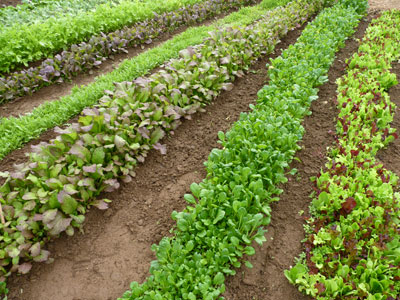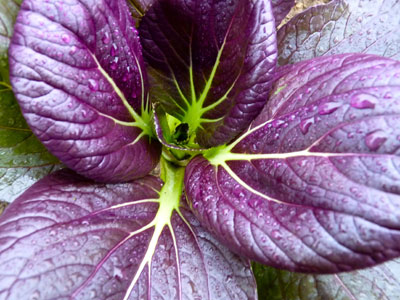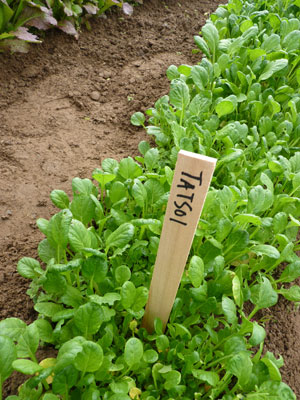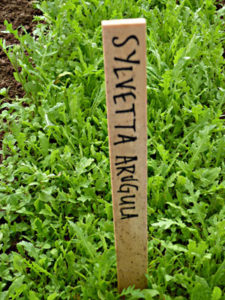 |
| Cold-hardy greens sown on Aug. 18 by Johnny’s Selected Seeds and displayed five weeks later at the Common Ground Country Fair. English photo. |
By Roberta Bailey
A Maine (northern) garden is always in transition. In my mind, I can visualize it as if through time-lapse photography. In spring we rapidly progress from young garlic and overwintered scallions pushing through the snow to neat rows of green sprouts. The rows fill out as summer progresses until the paths narrow and sometimes disappear. Late July is garlic harvest, which opens new ground, an empty palette for fall planting. Killing frost and garden cleanup empty much of the canvas, leaving the now sizable fall greens planting as the focal center of attention. Next come the caterpillar humps of low or high tunnels with overwintered greens.
I particularly enjoy the late summer transition. In my gardens, that transition centers around the garlic patch. In the first week of July, I plant short season peas, such as ‘Sugar Ann’ or ‘Coral’, between my garlic rows (which are spaced 20 inches apart). When the garlic is harvested, voila! Instant pea patch, ready for staking and a vast expanse of fall planting potential. As the patch was thickly mulched, few to no weeds grow. I part the mulch, add a bit of nitrogen (usually as alfalfa or fish meal with a bit of soy and kelp meal as well), and then plant fall greens. Regular watering or drip irrigation is necessary, as the ground is too dry for optimal germination.
 |
| Purple Pac choi (aka Pak choy). English photo. |
 |
| Tatsoi. English photo. |
Last year’s garlic patch turned into late cucumbers, snap peas, green beans, a new strawberry bed (the runners with a few roots established easily) and most of my fall greens. Some of the greens I hope to overwinter; others, I know, will eventually succumb to the intense cold but will feed us well into December. From October through December, a gardener can easily maintain and eat bok choy, pak choy (the purple pak choy is quite hardy), Chinese cabbage, mustard, Chinese broccoli, spinach, mache, lettuce, cilantro, kale, arugula, parsley, Swiss chard, leeks, scallions, claytonia, minutina, tatsoi, endive, radicchio, cress, beets and beet greens, collards, kohlrabi, carrots, cabbage, rutabagas, radishes, parsnips and mustard-spinach crosses.
I planted a lot of gai lan or Chinese broccoli. The tender, thick-stemmed shoots with loose broccoli florets are my favorite food of this year. I planted ‘Te You’, ‘Wan Shen’ and ‘Green Lance’, each of which grew well. In the next few years, I hope to learn which if any varieties overwinter and which do well in spring or summer. In late July, I also started ‘Santee’ sprouting broccoli, which promises to be winter hardy as well.
My strategy has been to cover my plantings after they are established. In the warmer fall weather that Maine is experiencing, I wait until mid- to late October to place hoops and row covers over the crops. My systems are evolving. For my larger frame, I currently use arcs of 20-foot reinforcement bar for my frame, with rebar or conduit pipe lashed on as the horizontal supports, and a heavy plastic covering. Inside the low tunnel, I cover the rows with wire hoops and polyspun row cover. I hope to move toward an Eliot Coleman-inspired system of conduit hoop low tunnels with a larger framed tunnel over all the low tunnels. I aim to make lightweight, portable frames that we can move onto our established crops in late fall. The slower months of winter are ideal times to build such structures. If I leave it until October, finding the time is difficult.
Since my systems have been less than ideal, I have discovered some varieties that are very resilient and cold hardy and some that eat snow for breakfast. ‘Kolibri’ kohlrabi frequently overwinters with nothing more than snow cover. Similarly I have had ‘North Pole’, ‘Hyper Red Rumpled’, ‘Dark Red Lolla Rossa’ and ‘Brun d’Hiver’ lettuce survive with nothing more than row cover on them. (‘Brun d’Hiver’ is hard to find as a single variety but is included in Fedco’s winter lettuce mix.) ‘White Russian’ kale is a nice cultivar in fall and overwinters regularly – and, if under cover, puts out copious side shoots as soon as the days begin to lengthen. If in the garden with little protection, it starts to produce by early April. I leave the overwintered plants to go to seed. They broadcast their seed and I frequently have carpets of kale volunteers around my garden.
Here are varieties that I have found perform well:
Lettuce – ‘Winter Density’, ‘Rouge d’Hiver’, ‘Brun d’Hiver’, ‘Winter Marvel’, ‘Arctic King’, ‘Oscarde’, ‘Red/Royal Oakleaf’, ‘Dark Red Lolla Rossa’, ‘Valdor’, Fedco’s winter lettuce mix, ‘North Pole’, ‘Red-Tinged Winter’, green and red ‘Deer Tongue’, ‘Merlot’, ‘Bronze Mignonette’, ‘Blushed Butter’ cos, ‘Hyper Red Rumpled’ and ‘Tango’
Spinach – All do fairly well. ‘Winter Giant’ and ‘Winter Bloomsdale’ may have a slight edge.
Beets – ‘Bull’s Blood’
 |
| ‘Sylvetta’ arugula. English photo. |
Turnips – ‘Oasis’ and ‘Hakurei’
Collards – All are good, but Seed Saver’s Exchange ‘Old Timey Blues’ is purple-tinged and gorgeous.
Carrots – ‘Napoli’
Arugula – ‘Sylvetta’
Asian greens – ‘Purple’ pak choy, ‘Joi choi’, tatsoi, komatsuna mustard-spinach, misome, ‘Osaka Purple’ mustard, mizuna, mibuna
Herbs – cilantro, parsley
Miscellaneous greens – minutina, ‘Vert de Cambrai’ mache, claytonia, cress, salad burnet, watercress, ‘Bianca Riccia’ endive, ‘Palla di Fuoca Rossa’ radicchio, sorrel
Kohlrabi – ‘Kolibri’
Leeks – ‘Siegfried Frost’, ‘King Sieg’, ‘Bandit’
Scallions – ‘Evergreen Hardy White’, Welsh onions
Kale – ‘Winterbor’, ‘White Russian’, ‘Lacinato’
Broccoli – ‘Santo’, ‘Arcadia’, ‘Piracicaba’
Every winter and every soil and every niche create conditions as varied as their gardeners and their overwintering setups. Experiment. Let us all know what you learn.
About the author: Roberta Bailey raises vegetable and flower seed crops on Seven Tree Farm in Vassalboro and works for Fedco Seeds as a division co-ordinator.
